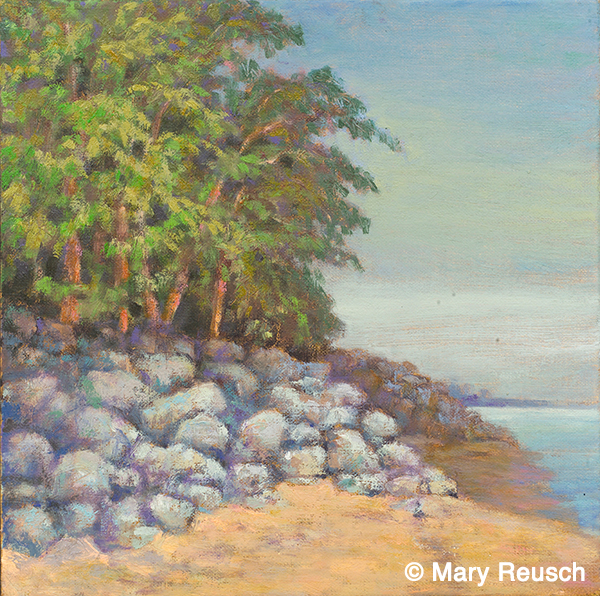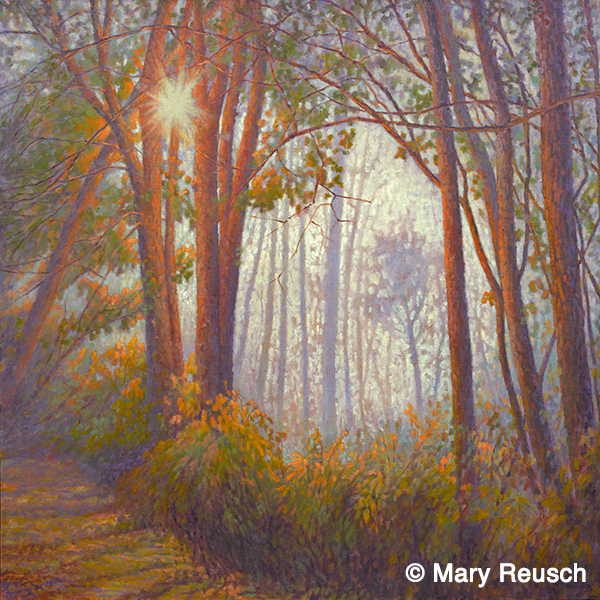












Grand Rapids, michigan, usa
STATEMENT
Painting landscapes gives me the opportunity to go out into nature and observe it very closely. Standing in a meadow, or in a forest, or on the shore of a lake gives me a chance to soak up the essence of the land and enjoy its rhythms. Everywhere I turn, I see vignettes of these rhythms and compositions, and then need to pick and choose those scenes that express most aptly what I am sensing from that particular spot. I spend a fair amount of time walking near my home, and I love being absorbed in this landscape.
Fall is the season I most vigorously venture out to paint the landscape. The changing colors and misty mornings draw me out of bed before dawn to climb a hill, or walk around a lake, to catch that singular moment in time- no morning being the same as another. Quickly I try to capture what I see on canvas and then run back to the studio to work out details. In the afternoon I scout out new places to get the last few rays of sun in the day, when our world is again transformed into color and light! Of particular interest to me is the fog which evokes a sense of mystery and poetry that gives metaphor and meaning to some of what I feel and want to articulate about our world and landscape. I also was entranced by painting directly into the sun, where one is blinded by the light, with trees and distance assuming bright, unearthly colors.
Capturing these many scenes is a time-honored vision. As civilization has encroached on the landscape, artists have been working hard to preserve the memory of wild areas. One such group were the Barbizon painters from 19th century France, who first felt the impact of industrialization. Painters like Rousseau and Millet strove to monumentalize everyday life and their surroundings, bringing in new honesty and soul to the world of painting. These ideas were echoed a few years later here in the United States by artists such as George Inness as he endeavored to give his landscapes a sense of the divine. My own connection to the natural world causes me to want to capture what I observe and experience. As our current wilderness continues to disappear right here in West Michigan, and we spread out and build more and more, I find that what we have left is increasingly sacred in my eyes.
STATEMENT
Painting landscapes gives me the opportunity to go out into nature and observe it very closely. Standing in a meadow, or in a forest, or on the shore of a lake gives me a chance to soak up the essence of the land and enjoy its rhythms. Everywhere I turn, I see vignettes of these rhythms and compositions, and then need to pick and choose those scenes that express most aptly what I am sensing from that particular spot. I spend a fair amount of time walking near my home, and I love being absorbed in this landscape.
Fall is the season I most vigorously venture out to paint the landscape. The changing colors and misty mornings draw me out of bed before dawn to climb a hill, or walk around a lake, to catch that singular moment in time- no morning being the same as another. Quickly I try to capture what I see on canvas and then run back to the studio to work out details. In the afternoon I scout out new places to get the last few rays of sun in the day, when our world is again transformed into color and light! Of particular interest to me is the fog which evokes a sense of mystery and poetry that gives metaphor and meaning to some of what I feel and want to articulate about our world and landscape. I also was entranced by painting directly into the sun, where one is blinded by the light, with trees and distance assuming bright, unearthly colors.
Capturing these many scenes is a time-honored vision. As civilization has encroached on the landscape, artists have been working hard to preserve the memory of wild areas. One such group were the Barbizon painters from 19th century France, who first felt the impact of industrialization. Painters like Rousseau and Millet strove to monumentalize everyday life and their surroundings, bringing in new honesty and soul to the world of painting. These ideas were echoed a few years later here in the United States by artists such as George Inness as he endeavored to give his landscapes a sense of the divine. My own connection to the natural world causes me to want to capture what I observe and experience. As our current wilderness continues to disappear right here in West Michigan, and we spread out and build more and more, I find that what we have left is increasingly sacred in my eyes.